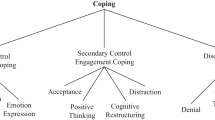Abstract
The present study was designed to examine the reported Stressors and patterns of coping strategies used by adolescents and extend the 1989 work of Carver et al. by reporting internal reliability, factorial validity, and normative data on the COPE for a sample of middle adolescents. A sample of 484 ninth through twelfth graders (ages 14–18) attending a Laboratory High School participated in the study. The COPE inventory developed by Carver et al. in 1989 for use with college students, was administered with a battery of measures to all adolescent participants in their classrooms. Results indicated sufficient internal consistency for the measure and significant gender differences. Factor analysis of the COPE indicated that the subscales consistently fell into four factors rather than the traditional two (i.e., problem focused vs emotion focused). Implications for using the COPE in research on adolescent were discussed.
Similar content being viewed by others
References
Allen, S., and Hiebert, B. (1991). Stress and coping in adolescents.Can. J. Counsel. 25: 19–32.
Carver, C., Scheier, M., and Weintraub, J. (1989). Assessing coping strategies: A theoretically based approach.J. Personal. Social Psychol. 56: 267–183.
Compas, B. (1987). Coping with stress during childhood and adolescence.Psychol. Bull. 101: 393–403.
Compas, B., Malcarne, V., and Fondacaro, K. (1988). Coping with stressful events in older children and young adolescents.J. Consult. Clin. Psychol. 56: 405–411.
Dise-Lewis, J. (1988). The life events and coping inventory: An assessment of stress in children.Psychosom. Med. 50: 484–499.
El-Shiek, M., Klaczynski, P., and Valaik, M. (1989). Stress and coping across the life course.Human Develop. 32: 113–117.
Endler, N., and Parker, J. (1990). Multidimensional assessment of coping: A critical evaluation.J. Person. Social Psychol 58: 844–854.
Fanshawe, J., and Burnett, P. (1991). Assessing school-related Stressors and coping mechanisms in adolescents.Br. J. Educat. Psychol. 61: 92–98.
Folkman, S., and Lazarus, R. (1980). An analysis of coping in a middle aged community sample.J. Health Social Behav. 2: 219–239.
Folkman, S., Lazarus, R., Dunkel-Schetter, C., Delongis, A., and Gruen, R. (1986). Dynamics of a stressful encounter: Cognitive appraisal, coping, and encounter outcomes.J. Person. Social Psychol. 50: 992–1003.
Folkman, S., Lazarus, R., Pimley, S., and Novacek, J. (1987). Age differences in stress and coping processes.Psychol. Aging 2: 171–184.
Forsythe, C., and Compas, B. (1987). Interaction of cognitive appraisals of stressful events and coping: Testing the goodness of fit hypothesis.Cog. Ther. Res. 11(4): 473–485.
Hollingshead, A. B. (1975). Four factor index of social status. Unpublished manuscript. Yale University, Department of Sociology, New Haven, CT.
Lazarus, R., and Folkman, S. (1987). Transactional theory and research on emotions and coping.Eur. J. Personal. 1: 141–169.
Patterson, J., and McCubbin, H. (1987). Adolescent coping style and behaviors: Conceptualization and measurement.J. Adolesc. 10: 163–186.
Rutter, M. (1981). Stress, coping and development: Some issues and some questions.J. Child Psychol. Psychiat. 22: 323–356.
Spirito, A., Stark, L., Grace, N., and Stamoulis, D. (1991). Common problems and coping strategies reported in childhood and early adolescence.J. Youth Adolesc. 20: 531–544.
Stark, L., Spirito, A., Williams, C., and Guevremont, D. (1989). Common problems and coping strategies I: Findings with normal adolescents.J. Abnorm. Child Psychol. 17: 203–212.
Tolor, A., and Fehon, D. (1987). Coping with stress: A study of male adolescents' coping strategies as related to adjustment.J. Adoles. Res. 2: 33–42.
Author information
Authors and Affiliations
Additional information
Partial support for this project was obtained from the Society for the Psychological Study of Social Issues and by Illinois State University's Graduate Student Association, Graduate School, and Psychology Department.
Received master's degree at Illionos State University. Research interests include social development in adolescents.
Receaved doctoral degree in experomental psychology from Virginia Commonwealth University. Research interests include life span social development.
Rights and permissions
About this article
Cite this article
Phelps, S.B., Jarvis, P.A. Coping in adolescence: Empirical evidence for a theoretically based approach to assessing coping. J Youth Adolescence 23, 359–371 (1994). https://doi.org/10.1007/BF01536724
Received:
Accepted:
Issue Date:
DOI: https://doi.org/10.1007/BF01536724



